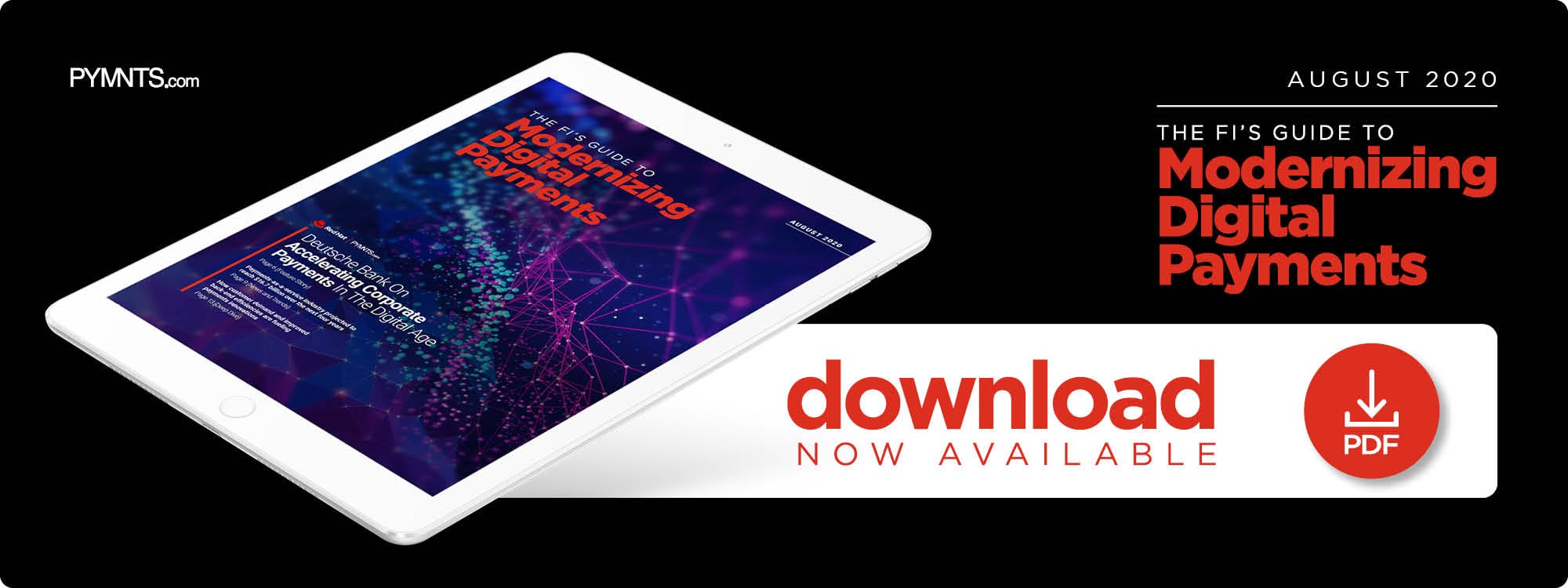Deutsche Bank On Accelerating Payments In The Digital Age

Immediacy has become the name of the game for vendors and suppliers facing crumbling revenue streams. But banks can find themselves struggling to facilitate faster B2B payments. In this month’s The FI’s Guide to Modernizing Digital Payments, PYMNTS talked to Vikram Dewan, CIO at Deutsche Bank, about how regulatory compliance complicates payments digitization and why change must begin by shifting away from paper.
Payments are everyday occurrences for businesses and consumers, and they have been for thousands of years.
Transactions once conducted by trading pieces of gold are now accomplished through digital means, with both parties using cards, wire transfers or even smartphone apps to send or receive funds. These transactions often take hours or days to clear, however, which can result in frustration because funds are often needed as soon as possible.
This is changing what companies and consumers look for regarding payments. Many are demanding seamless, instant transactions that they can complete with their smartphones, but enabling these experiences comes with challenges, according to Vikram Dewan, chief information officer of Deutsche Bank’s corporate banking division.
“The Johns and Marys of the world are even more demanding than the Siemens and the GEs,” he said. “Corporations obviously have a more complex infrastructure, but even they are wanting to [transact] more and more like consumers.”
PYMNTS spoke with Dewan about the changing nature of corporate and consumer payments as well as how the emerging FinTech scene has influenced this field and how the ongoing pandemic has placed even more stress on banks to meet these expectations.
How Expectations Surrounding Payments Are Changing
Corporate customers’ and individuals’ payment goals are largely similar, Dewan explained, as both want payments to be delivered as quickly as possible with minimal hassle. Businesses — especially digital-savvy clients like FinTechs — also desire flexibility for their payment platforms. They typically require constant feedback at every stage of the payment process, and some even desire the option to integrate their own payment platforms.
“Not everyone is willing to go through one channel to be able to process a payment,” Dewan said. “Some would process their payments to their own enterprise resource planning solutions like SAP and others. Some don’t have an issue using our own desktops, but many will use their own mobile devices. The world keeps changing on us in terms of the channels.”
Myriad obstacles stand in the way of these goals, however. Several procedures must be conducted before payments clear, and this is especially true for cross-border transactions. Banks can make their links on the payments chain instant, but other parts are out of their control.
“It starts with the payment issuance,” Dewan explained. “If they have their own channel to do so, that channel needs to be able to connect to the recipient, and you need to check many things to allow that payment to get out of the bank. You need to check the funds. You need to check who they’re making the payment to. You need to do regulatory monitoring on it for anti-money laundering and, depending on [the country in which] you’re making the payments, you need to ask if there are any foreign exchange transaction fees. All the links in the chain need to be real time, but unfortunately many are not.”
Customers are not the only ones influencing the nature of instant payments, however. Growing numbers of FinTechs are also forcing banks to innovate or be left behind.
How FinTechs Have Influenced the Payments Scene
FinTechs compete with traditional banks in many ways, but they can also be financial institution (FI) customers and partners when developing payments infrastructures. Banks that team up with FinTechs can get better looks at the products and services they are developing and determine what they are up against, but these firms have some natural advantages not shared by most FIs.
“They’re able to build things faster than we can at times because they don’t have to carry the 150-year legacy of what we are built on,” Dewan said. “They are definitely more agile. They’re definitely faster. And they have fewer rules and regulations to comply with, which keeps us on our toes.”
Dewan said the best way to compete with this agility and talent is for banks to adopt it as their own. A company is only as effective as the minds that contribute to it, so ensuring that those minds are working for traditional banks goes a long way toward evening the playing field.
“We are actually able to attract talent from them and compete with them on talent,” he explained. “We bring in new ideas and make ourselves as agile as possible. So, there’s definitely an opportunity and a threat at the same time.”
There is more talent than ever in the market right now. The pandemic has left millions of individuals looking for jobs, many of whom are in the banking or payments sectors. The health crisis has also been a game-changer when determining what companies look for in payments providers as it has dramatically altered the daily operations of businesses around the world.
The Pandemic’s Impact on Payments
The economic downturn that accompanied the COVID-19 outbreak significantly affected the payments space. Vendors and suppliers facing crumbling revenue streams have been forced to collect on their invoices faster than ever as companies that fail to do so risk not receiving payments.
“As many industries started to face that big [drop-off in] revenues — especially in the entertainment, hospitality or travel industries, where things just screeched to a halt right away — for them, not receiving their payments on time or not being able to pay a particular supplier was very critical,” Dewan noted. “Cash on hand is more important than it’s ever been because of the uncertainty where you don’t know what to expect.”
Another pandemic-driven payments wrinkle is the unprecedented number of employees working from home. The risk of infection means being in the same room to transfer payments or sign documentation is inadvisable, and companies are turning to digital documents and signatures now more than ever.
“Nobody is issuing $2 billion payments without multiple signatures on them, so we needed to introduce more digital controls because otherwise we would be at a standstill,” Dewan explained. “So, we were able to deploy digital signatures and digital documents where customers didn’t have to come and receive paper and transfer paper back to us.”
These digital shifts are likely to remain once the crisis has passed, but it will be incumbent on FIs to achieve the same level of innovation when it does.

